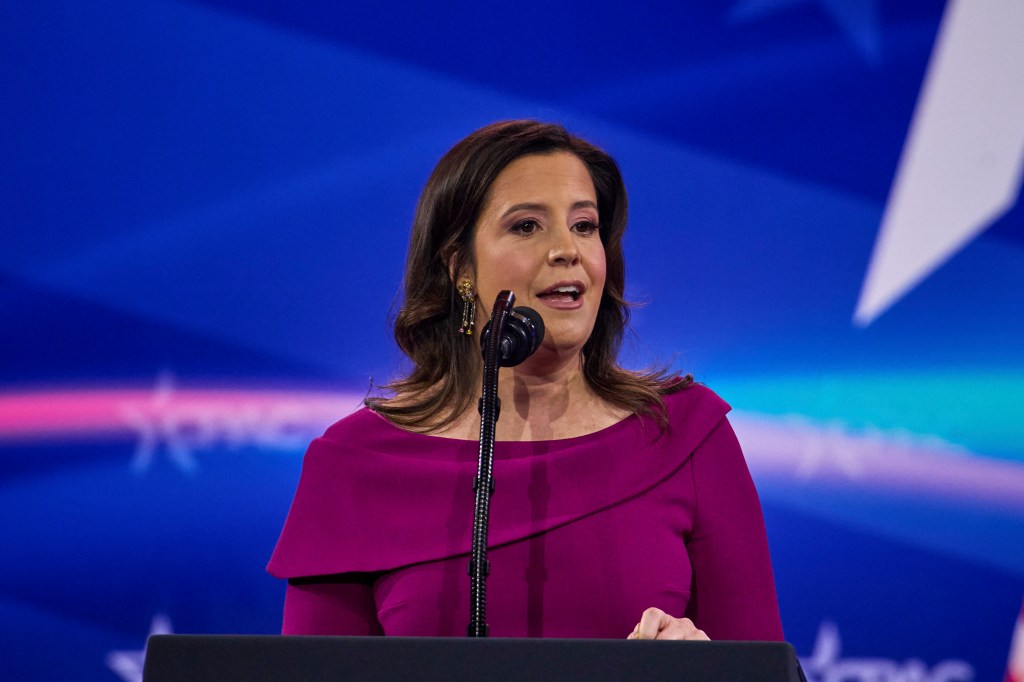
For all of the triumphalism GOP lawmakers and officials projected after securing a governing trifecta—control of the White House and both chambers of Congress—in the 2024 elections, the truth has always been this: Narrow margins in the House and Senate give Washington Republicans little room for error as they try to enact major changes in Donald Trump’s second administration.
The most recent reminder of that reality came Thursday afternoon, with the announcement that Trump would be pulling his nominee for ambassador to the United Nations, Rep. Elise Stefanik, so that she could keep her seat in the House and prevent Speaker Mike Johnson from losing another reliable vote.
“As we advance our America First Agenda, it is essential that we maintain EVERY Republican Seat in Congress,” Trump wrote in a post on Truth Social. “With a very tight Majority, I don’t want to take a chance on anyone else running for Elise’s seat. The people love Elise and, with her, we have nothing to worry about come Election Day.”
When it comes to Trump’s pronouncements, there usually isn’t a lot of subtext to parse. But hidden just under the surface of this message was a shocking implication: Republicans could actually lose Stefanik’s seat, either in a special election to finish her term or in next year’s midterm elections. The six-term congresswoman’s upstate New York district has a 9-point partisan advantage for the GOP, according to the Cook Political Report, and Trump won it by nearly 21 points in 2024. Could an open race really flip the seat to the Democrats?
Some in Washington have wondered whether Stefanik’s connections to the pre-MAGA establishment—from her White House jobs in the George W. Bush administration to her stints at various neoconservative think tanks—may have rendered her a casualty of the internal administration beef between the dominant doves and the party’s remaining hawks.
But if we take Trump at his word that Stefanik is more valuable as a reliable vote in the House than as his U.N. ambassador, it underscores the challenges of the GOP’s narrow majority in Congress and makes clear that the Republicans’ political trifecta could very well fall apart as the 2026 elections loom. And although the nation’s capital continues to be rocked by the Trump administration’s Silicon Valley shock troops, much of Trump’s agenda can only be enacted via legislation—and there remain serious limitations on what the GOP can do on Capitol Hill. There’s slightly more wiggle room in the Senate with 53 Republicans (and Vice President J.D. Vance as a tiebreaker), but with 218 votes, House Republicans currently have almost the bare minimum to constitute a majority. With such tight margins both in Congress and in public opinion, Trump has less control over his destiny than he might have hoped.
Nearly every Trump initiative thus far has faced legal challenges, from executive orders to funding freezes instituted by the Department of Government Efficiency. His immigration enforcement efforts have been subject to some of the most high-profile injunctions, and not only from federal judges appointed by Democrats. Even some Republican lawmakers have publicly blanched at Trump’s tariff plans—and markets just plain hate them.
That’s not to say Trump and Republicans are paralyzed. So far this year, Mike Johnson has managed to hold his slim majority together on the most consequential votes: on his election as speaker, on passing the House’s budget resolution, and on passing the resolution this month to continue funding the government. Just one Republican defected each time—remarkable party discipline, aided in large part by threats from Trump and his deputies that Republicans who derail action will face well-backed primary challengers.
Yet that unity may be fleeting as the midterms approach and House members in swing districts seek to distance themselves from a president with a negative approval rating and whose administration has made some embarrassing mistakes. Passing a debt ceiling increase or any of the administration’s legislative priorities will prove difficult enough with the current makeup of the House. But if Republicans see too much attrition from their ranks on controversial votes—or even lose their majority outright? Forget about it.
Trying to extrapolate too much from early and local elections is often a fool’s errand, but there are signs that discontent with Trump and the GOP’s total control in D.C. is on the rise. Just this week, a Democrat scored an upset victory in a special election to the Pennsylvania State Senate, taking a Lancaster County seat the GOP had held since 1979. That followed a special Iowa State Senate election back in January that also flipped control of a longtime Republican seat to the Democratic Party. And ahead of next week’s closely watched state Supreme Court election in Wisconsin, the liberal candidate has raked in an impressive amount of cash—$24 million in total—to match with the conservative, Trump-backed candidate who also has financial support from Elon Musk.
Trump and the GOP may be loath to admit it outright, but this is a political environment where no one can take any chances. And so Stefanik must stay in the House, giving Republicans the chance to keep fighting for Trump’s agenda, while they still can.

















